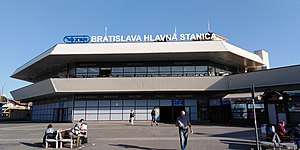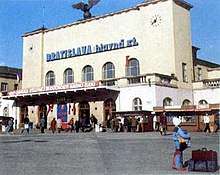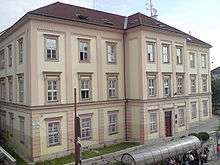Bratislava main railway station
Bratislava main railway station (Slovak Bratislava hlavná stanica, abbreviated Bratislava hl.st.) is the major railway station in Bratislava, Slovakia.[1] It is located near Šancová Street, around 1 km or a 15 min walk north from the historical part of the Old Town.[2]
Bratislava main railway station Bratislava hlavná stanica | |
|---|---|
 View of the main entrance to the station | |
| Location | Námestie Franza Liszta 1 Bratislava I 811 01 Bratislava |
| Coordinates | 48°09′30″N 17°06′22″E |
| Elevation | 130 m (430 ft) |
| Owned by | Železnice Slovenskej republiky (ŽSR) |
| Operated by | Železničná spoločnosť Slovensko (ZSSK), RegioJet (RJ) |
| Platforms | 6 |
| Connections | Tram: Route 1 and 2 Bus: City buses and trolleybuses |
| Construction | |
| Architect | Ignatz Feigler Jr. Ferenc Pfaff |
| History | |
| Opened | 20 August 1848 |
| Rebuilt | 1850, 1988 |
| Location | |
 Bratislava main railway station Bratislava hlavná stanica Location within Slovakia | |

Apart from domestic routes, international routes from this station depart to Austria, Croatia (in summer only), the Czech Republic, Germany, Hungary, Poland, Serbia, and Switzerland[3][4].
Etymology
Prior to 1919 the city was part of the Austro-Hungarian Empire, and was known as "Pressburg", in German, and "Pozsony", in Hungarian. The station was named Pressburger Hauptbahnhof and Pozsony főpályaudvar in those languages.
History

The first station building, a two-storey building at Šancová 1, now serves as the headquarters of the railway police. It was built in 1848 as the terminus for the Vienna - Gänserndorf - Bratislava (Pressburg) and Břeclav - Bratislava (Pressburg) lines. The second building, which is used to this day, was built after the completion of the Budapest - Párkány (Štúrovo) - Bratislava line in 1905 to the design of Ferenc Pfaff, who was the Hungarian State Railways's main architect at the time. Originally it was built in eclectic style, however in 1960 it underwent a major reconstruction, when the exterior was completely changed to be more "socialist" in nature. The frescos were added to the interior at the same time. The foyer, colloquially called "Skleník" (meaning "greenhouse"), was added to the second building in 1987 as an extension, which was meant only as a temporary solution already during its construction. This extension was scheduled to be demolished during the reconstruction of the Franz Liszt Square, which, though, has never been started by the investor, what led into a lawsuit by the city and the state-owned railway company. That caused a stall to any changes for many years. Newest plans by the railway company are just to renew the foyer and surrounding area, until a new station will be built.
In 1883, a connection was added to the Bratislava-Rača station, which was connected to the line to Žilina. The line to the Nové Mesto station is the most recently added line, and it was built in 1962
At first, the station also had freight loading and unloading facilities. One unique feature was the "vínovod" ("wine transport system"), which consisted of tubing from the station to the Palugyay family's wine cellars.[2] Gravity flow drew wine from trains into barrels in the cellars.[5] The station also had a ropeway conveyor to Patrónka (cartridge factory) which produced ammunition cartridges, colloquially known as "patróny". As passenger traffic increased, freight operations were progressively relocated to other stations in the city.
The station's engine house by the stabling yard was built after the removal of the old stabling yard, which was formerly in the space occupied by platforms 3-5.
On January 1, 1919, as Czechoslovak troops were about to enter the city, negotiations between representatives of the Pressburg population, led by Paul Wittich, and Entente officers, led by the Italian Colonel Barreca, took place at the Pressburg railway station.[6]
Current situation
Current rail traffic exceeds the station's track capacity, which occasionally becomes evident in a domino effect caused by delayed trains. One suggested solution is to transfer some of the trains to the Nové Mesto and Petržalka stations, which currently have unused track capacity.
Future reconstruction
Since 2000, there have been plans to reconstruct not only the station but also the surrounding area, most importantly the Franz Liszt Square.[7] The investor is the company I.P.R. Slovakia and the cost was estimated at €232,357,432 in 2008. In 2003, the Bratislava City Magistrate agreed with the project. In 2006, the Old Town district of Bratislava and the Regional Environment Office decided to allow I.P.R. Slovakia to cut down 630 trees worth €230,000 and shrubs worth of €14,000. The decision is final and according to experts, when executed it will forever change the micro-climate of the area.[8] Since 1 September 2007 a new City plan came into effect in Bratislava and in 2008 the Old Town district informed the investor that he needs another agreement from the Bratislava City Magistrate.
Access
Bratislava main station serves as the hub for the local public transport service (MHD). It can thus be conveniently accessed from all parts of Bratislava. Many buses and trolleybuses terminate here as well as almost all of the night buses for which station serves as the hub.
Tram routes number 1 and 2 commence at the station and serve both the old town and the new town. In 2012 the government allocated part of a €420m transport funding package towards the construction of a segregated light rail line from the main station to the Šafárik Square and Janíkov Dvor, and modernisation of the existing tram route to Dúbravka.[9]
Military shelter
Bratislava main station features one of the city's major war shelters built during the communist era, to protect citizens from air raids or attacks with weapons of mass destruction. As with many other similar structures in Bratislava, it is inaccessible and not widely known to the public. Built in the 1950s, it is located underneath the Jaskový rad Street and nearby houses and its designed capacity is 1,500 people. The main entrance can be found at the very end of the tunnel leading to platforms, after leaving the tunnel, the entrance is behind a small metal door built into the massive rock wall.
The shelter features several hallways, rooms, a command centre, air filtering and power generating machinery and toilets. There are two emergency exits, one behind Hotel Spirit and the other behind the building known as U Matúša, which in the past featured a pub with the same name, both on private property. The shelter belongs to the Railways of Slovak Republic.
Services
| Preceding station | Železničná spoločnosť Slovensko | Following station | ||
|---|---|---|---|---|
| Kúty toward Berlin |
EuroNight EN Metropol |
Nové Zámky toward Budapest | ||
| Kúty toward Prague or Ostrava |
EuroCity | Nové Zámky toward Budapest occasional terminus | ||
| Terminus | InterCity | Trnava toward Košice | ||
| Terminus | Regional fast trains | Bratislava-Vinohrady toward Zvolen or Štúrovo | ||
| Terminus | Regional fast trains | Bratislava-Vinohrady toward Košice or Žilina | ||
| Terminus | Regional Express | Bratislava-Vinohrady toward Trenčín or Trnava | ||
| Terminus | Regional Express | Bratislava-Vinohrady toward Prievidza | ||
| Devínska Nová Ves toward Kúty or Břeclav |
Regional Express | Terminus | ||
| Terminus | Regional Express | Bratislava-Vinohrady toward Nové Zámky | ||
| Bratislava-Lamač toward Vienna |
Regional Express | Terminus | ||
| Bratislava-Železná studienka toward Kúty or Malacky |
Stopping trains | Terminus | ||
| Terminus | Stopping trains | Bratislava-Vinohrady toward Nové Zámky | ||
| Terminus | Stopping trains | Bratislava-Vinohrady toward Leopoldov | ||
| Preceding station | RegioJet | Following station | ||
| Terminus | RegioJet | Bratislava-Nové Mesto toward Komárno |
Gallery
- Main entrance to the station.
 The large interior fresco in its context in the main hall.
The large interior fresco in its context in the main hall. Paintings inside the station's hallway.
Paintings inside the station's hallway. Another close-up of the paintings inside the station's hallway.
Another close-up of the paintings inside the station's hallway. Bratislava main station August 2014
Bratislava main station August 2014
References
- Tim Nollen. The Czech and Slovak Republics. Rough Guides.
- "Bratislava Hlavna Stanica". Rail Europe. Archived from the original on 2010-12-01. Retrieved 2013-05-07.
- https://www.slovakrail.sk/
- https://imgur.com/a/1kGAg2t
- "Slovakia Document Store: S vareskou dvoma tisicrociami / Kapitolky z dejin bratislavskej kuchyne s receptami nasich predkov". Archived from the original on 2009-09-28. Retrieved 2009-03-12.
- Duin, Pieter van. Central European Crossroads: Social Democracy and National Revolution in Bratislava (Pressburg), 1867-1921. New York: Berghahn Books, 2009. p. 211
- "Územné rozhodnutie na Predstaničné námestie chcú do konca roka". 2008-11-09.
- Tkáčiková, Lucia (28 August 2011). "Pri hlavnej stanici padne viac než šesťsto stromov (Over 600 trees will be cut down near the Main Railway Station)". SME. Retrieved 9 May 2012.
- "Bratislava urban transport funding reallocated". Railway Gazette International. 7 November 2012.
- Catchpole, Paul (1998). Steam and Rail in Slovakia. Kings Norton, Birmingham, England: Locomotives International. ISBN 1-900340-08-9.
External links
| Wikimedia Commons has media related to Bratislava hlavná stanica. |
